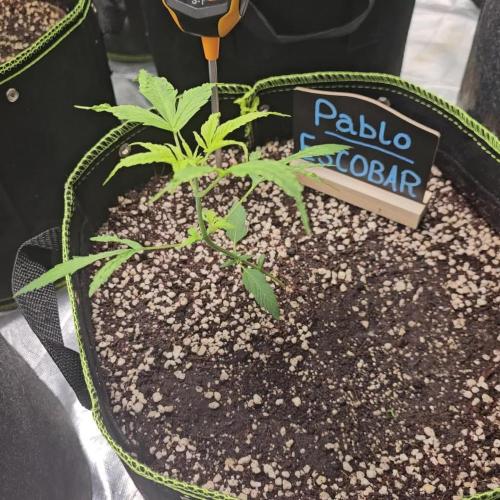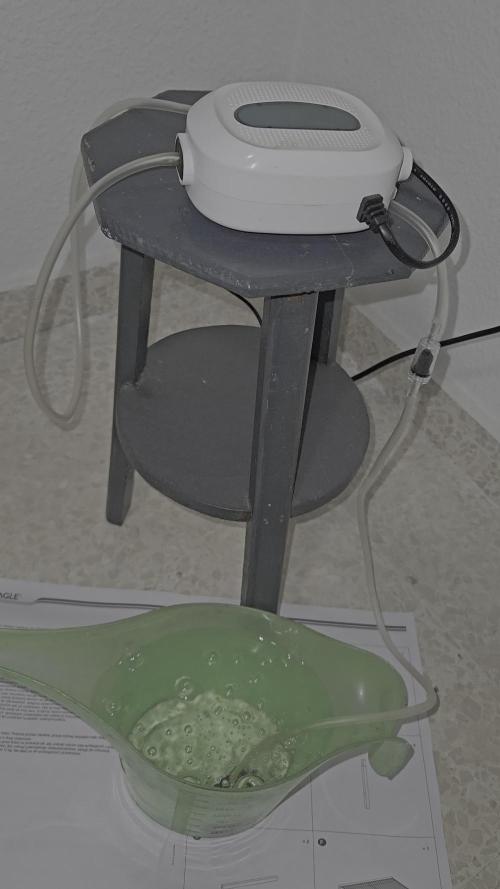The Grow Awards 2026 🏆 

































Likes
Comments
Share


@GrowGuy97
Follow
Day 28 - RH 58% Temp 81F . Ladies are growing great, they are really starting to turn into little bushes & the double mainline is going strong 💪🏻 Thanks for following friends & make sure to check back for daily updates! Happy growing✌️🏼🌱
Day 29 - RH 57% Temp 78F . Couldn’t be happier with the growth!
Day 30 - RH 60% Temp 78F . Everything is looking great!
Day 31 - RH 51% Temp 78F . Watered today with PH at 6.5, all 3 ladies are doing amazing!👍🏼
Day 32 - RH 53% Temp 81F . Considering topping the ladies tomorrow not sure yet! Still growing beautifully!
Day 33 - RH 52% Temp is 80F - Bushing out like crazy & growing strong! The double mainline seems to be bouncing back as well! So far very impressed with this strain😍👍🏼
Day 34 - RH 56% Temp is 79F - Decided to top the two bushy plants today, they also got fed today with PH about 6.3
Likes
31
Share


@MrJones
Follow
MrJones VIPARSPECTRA XS1000 LED
📜 SUMMARY - I have been given the opportunity to run the next generation of LED lights by VIPERSPECTAR, the XS1000! I set up a Stealth Cabnient and moved 3 Cream Manderain Auto XL.s under these lights, the cabinet set up is automated with WIFI light controllers, and INKBIRD Temperature and Humidity Controllers, I am very excited about this opportunity!
Specs and Discount Codes Listed Below.
🔹🔹🔹🔹🔹🔹WEEKLY GOALS 🔹🔹🔹🔹🔹🔹
🌞Environment - 80F and 55%Humidity - using Humidfyer as needed.
💧 Feeding - Feeding with FOOP Canna Organic Nutrient Line
🍃Training / Super Cropped - and put 2 plants into a training hoop.
🕷️ IPM - Will be using Green Cleaner" 1 OZ per Gallon, and CannControl from Mammoth alternating between product each month for Integrated Pest Management.
💡 Vegetation & Flower (new) Viparspectra XS-1000 Release on March 15th.
🔹🔹🔹🔹🔹🔹🔹🔹🔹🔹🔹🔹🔹🔹🔹
📜 Week 8 and the buds are starting to get larger, thining I may have to clean up a few more fan leaves. great combination of Lights, Nutrients, Environment, and Strain.
🔹🔹🔹🔹🔹🔹🔹🔹🔹🔹🔹🔹🔹🔹🔹
▶️Monday 04.12.21 / Fed about 30 ounces today - looking great!
▶️Tuesday 04.13.21 / Fed about 30 ounces today - looking great!
▶️Wednesday 04.14.21/ laying off the feeding tonight, had to readjust one of the plants this afternoon, added some support to it.
▶️Thursday 04.15.21 / These ladies are doing well, the height is right up to the lights, but still looking pretty good. Drop the feed down to 20 ounces per day.
▶️Friday 04.16.21 / Fed about 20 ounces today - looking great!
▶️Saturday 04.17.21 / Fed about 20 ounces today - looking great!
▶️Sunday 04.18.21 / Fed about 20 ounces today - looking great!
🔹🔹🔹🔹🔹🔹🔹🔹🔹🔹🔹🔹🔹🔹🔹
VIPARSPECTRA XS1000 LED
🔹🔹🔹🔹🔹🔹🔹🔹🔹🔹🔹🔹🔹🔹🔹
Amazon US:
XS1000 10% off: in10MrJones http://yx-8.cn/0y-6
XS1500 5% off: in15MrJones http://yx-8.cn/0yA
XS2000 5% off: in20MrJones http://yx-8.cn/0y2Y
XS4000 5% off: in40MrJones http://yx-8.cn/0y5k
Amazon Canada
XS1000 10% off it10MrJones https://amzn.to/38udUVe
XS1500 5% off: it15MrJones https://amzn.to/3esVUyr
XS2000 5% off: it20MrJones https://amzn.to/3l5zAfg
XS4000 5% off: it40MrJones https://amzn.to/3l7k5Uj
Likes
1
Share


@Blaze_With_Haze
Follow
All babies growing up very fast. Very happy so far. Started to use lowdose Advanced Nutrients fertilizer.
Likes
48
Share


@Kirsten
Follow
Well this week has gone a bit pear shaped.
I think it is a combination of light stress and the new soil I'm using. Also the soil had fungus gnats. I won't use it again but it was an experiment and I've learnt that soil isn't my substrate of choice! Back to my super coco mix! 😁
I'm going to see if I can pull it through. I've got plants through worse! Wish me luck.
I watered twice this week with 1ltr of dechlorinated water PH'd to 6-6.5, containing 1ml of Ecothrive Trace and 1/4 TSP Ecothrive Biosys.
I will say that the soil is very difficult for me to judge the moisture level to water accordingly. Have I mentioned it don't like soil? 😒💚😂🍃✌️
Thanks for checking out my diary this week, I'm sorry its not a better update, but wish me luck! I'm going to need it here! 😂💚✌️
Likes
141
Share


@Anonymous_2022
Follow
Thanks for stopping by.. Please hit the like button if you like what you see and ill be sure to check you out too Growmies 🌱
Starting week 2 Of flower and they seem to be really stretching, given some defoliation below the first scrog and added a second net,
Seem to be getting quite a good canopy but will need a thin out as theres so many leaves blocking light for lower growth,
The Mars FC 3000 really does seem tobe doing great they seem to be happy girls 🌱
Likes
5
Share


@Tony_Montana84
Follow
So seit 2 Tage gebe ich kein Dünger mehr dazu. Die Dame wird in ca. 14-16 Tage geerntet. ;)
Likes
10
Share


@Reaper
Follow
seeds germinate in rockwool
untill roots hit the water i only use calmag and small amount of nutes
Likes
27
Share


@pifflestikkz
Follow
Day 100
Day 57 Flower
06/07/24 Saturday
Flushed with de-chlorinated tap water today pH 6.0.
Flushing using 10L of water with Flawless finish- I'll be using this every other flush. , getting 50% run off, I can't measure ppm, I have ordered the tool to start learning this way also. I haven't measured run off ppms before so will be interesting to see.
Smelling pungent, deep greens of colour coming through, hoping over the next 2 weeks she swells as she is not as dense as I was hoping 😅
Day 10day 58 Flower
07/07/24 Sunday
No feed /water today letting her dry off a little more.
Updated with a short 🤩💚
Day 102
Day 59 Flower
08/07/24 Monday
De-chlorinated tap Water 5L pH 6.0 + 3L Water +calmag 5ml to keep her from deficiency during 1st week of flush.
Updated a short video 😁
She's getting there.
Day 103
Day 60 Flower
09/07/24 Tuesday
No water, letting her dry off again ABIT, noticing a huge amount of trichome production, updated a short to see 😍.
Day 104
Day 61 Flower
10/07/24 Wednesday
Another 10L flush today , de-chlorinated tap water pH 6.0 with flawless finish. 10ml flawless finish to 10L water.
Updated pictures and video.
Day 105
Day 62 Flower
11/07/24 Thursday
Last day of the week, another big flush today! 10L de-chlorinated tap water pH 6.0 with 10ml Flawless finish 👌
Trichomes...😍
She maybe a 21 day flush we'll see how she goes next week with ripening.
Video updated.
Likes
9
Share


@TheBulldozerSicily
Follow
Inizio nuovo ciclo
Giovedì 26 settembre 2024
Aggiungo 75 lt acqua osmosi inversa ec 146 ph 9
Aggiungo tutti I nutrienti ottenendo ec 908 ph 6.5
Likes
17
Share


@RDWCGrowing
Follow
7/27/2023- Prep
Tent and system are cleaned and ready to go from my last grow. I have submitted my Journa for the Diary of the Month Competition here is to hopeing for good resutls.
7/28/2023- Germination Day 0- Seed initiation
Well lets get this new Grow started.. So My Dad Sent me a custom Strain that he wanted me to grow out and Breed for him. The Strain is Called Red Rhino:
Red Rhino is an amazing strain coming from Israel and boasts a 60% Sativa and a 40% Indica. This strian comes from crossing double gum and master kush. Effects are an increased appetite, as well as giving you ephoric feelings throughout the whole day.
RO Water Used
Added Hydrogen Peroxided
8/1/2023- Germination Achieved G-Day 1
Popped her head above the root riot today to say hello.. Woot first challenge when dealing with an unknown seed and a new Strain is getting the seed to pop and the lady to show life.
8/2/2023- Germination Day 2
Took the root riot out today and it was soaked not good plant drowing again. I am still having a hard time finding the right blance for where the water should be to keep the root riot moist and not soaked. I had to drain some of the water out of the root riot plug to help give a little oxygen. I also removed some of the water.
8/3/2023- Germination Day 3
Looking good stretching her leaves out to let in the lights
8/4/2023- Germination Day 4
Looking good a few days until I put them into the RDWC System and get this thing rocking and rolling.
8/5/2023- Germinaiton Day 5
Looking good will probably plant tomorrow if the roots are still looking good.
8/6/2023- Plant Day- Germination Day 6
Planted into the RDWC System today. Joy when they go into the system as long as we dial that in right this will now be a great grow.. Survived the hard part..
8/7/2023- Germination Day 7
Fell over today I am worried.., she is showing some damage on the lower leaves from the over watering in the cloning machine but right now I don't see any new damage.
Supported the Stems with little improvised pole to help her stand up.
8/8/2023- Germination Day 8
Added the first Nutes today, to help support root growth and to help give there first jump to growth.
TPS SILICA GOLD-.5mil/Gal
Root Drip- 1mil/Gal
GH FLoraMicro-1mil/Gal
GH FlroaGro-1mil/Gal
GH FLroaBloom-1Mil/Gal
ORCA-.5mil/Gal
8/9/2023 - Germination Day 9
Everything is looking good new growth looks like it is praying and they are looking happy. I will take off the damage leaves probably tomorrow.
8/10/2023- Germination Day 10
Everything is looking good looks like she is recoving well, with just a little bit of a delay. Cleaned up the dead leaves... Day 1 VEG tomorrow.. Water Change Day and first real meal...
Likes
2
Share


@Takeaims
Follow
I cant beilve how big hybrids and xxl auto grow these are the best results I've ever had i won't be going back to autos again sweet seeds have a really good range of f1 hybrids and autos I haven't had a problem with any of there seeds so easy to grow and loads of fun can't wait to start more
Likes
16
Share


@NMGDOC
Follow
Semana del 12 al 18 de abril
Cada día más bonitas. Estoy feliz porque como hay menos humedad ambiental, hay menos humedad en el indoor. Incluso llegando a 43% de humedad, así que me confirmo. La temperatura suele andar por 24-26 grados Celsius así que bien.
Tenía unas 10 hojas dañadas por la mosca negra, así que el 12 de abril apliqué el insecticida tec fort (foto del producto en la semana anterior). Lo apliqué a las 17:00 hrs y a las 22:30 del mismo día no vi ningún bicho. Dentro de 5-6 días volveré a aplicarlo igualmente (1ml por cada litro).
Al menos dos de las cuatro plantas están tomando otro color, así que me conformo.
Likes
10
Share


@SgtDoofy
Follow
2/6:
Amnesia 3 is just about 6 inches tall now. Trainwreck is only a couple inches behind. Still keeping the temps between 73-82 and the humidity in the mid to low 70s. After thoroughly watering the very healthy, young tomato plant that coesxists in the tent, the tips of some of the leaves turned yellow. That makes me wonder if soaking the soil for the first time since transplant caused a bit of nutrient burn. I'm going to avoid any nutrients the first time I water Amnesia 3 and Trainwreck fully, to avoid the same potential issue. They're not looking too thirsty yet though.
2/8:
Amnesia 3 is tall enough and has a thick enough main stem to start slowly low stress training with a rubber coated gardening wire. I pre-drilled holes in my buckets for this occasion, and the wire fits well. Each day for the next week I'll gently pull the wire to slowly bend the main stem downwards, similar to how braces work on teeth: a long, slow procedure.
2/9:
Woke up to Trainwreck's leaf tips pointing downwards, so I took it as a sign to go ahead and give it its first watering. I siphoned up a bit of the runoff water, and it came back at a PH of 4! That's not good; however, after researching a bit, it's likely that I could have siphoned up a pocket of low PH nutrient-filled water, making my reading way off in terms of the PH of the whole slurry of runoff. If the leaves don't bounce back, I'm going to take that as a potential sign of Nitrogen toxicity and will monitor more closely. Will probably make plans for a flush if it progresses any worse than downward leaves. Nitrogen toxicity can cause fragile, dark green leaves that point down in a shape similar to a claw, among other symptoms.
2/12:
Watered Amnesia 3 for the first time since transplant. Getting taller and less bushy in some spots, so I may turn up the lights from 60 to 75% tomorrow, to see if I can increase some more growth. But before, I want to make sure this watering doesn't cause any nute burn from the soil.
Likes
5
Share


@ChiloteAnonimo
Follow
- Día 1 de la segunda semana de flora con riego foliar de calmag
- Videos tomados día 2 de la segunda semana
Likes
19
Share


@GeOMaTTiC
Follow
Diary Legend:
💧- Watered
🌱- Seedling
🌲- Cut Down
🍃- Defoliation
✂️- Topping or FIM'ING
🚂- Training (LST)
Wk7
10/20/21: Day 43. 💧Plant is looking much better overall. Leaves are getting the green back slowly, not that it matters much at this point. Buds are getting very fat and crystaly, and the smell is getting more intense each day. If the buds keep growing, I can see this yielding a bit more than originally anticipated on Day 34
10/22/21: Day 45. Not entirely sure what is going on, the plant seems to want to go yellow still. The buds still look good, so I'm not sure if they are just sucking out the nitrogen. Buds are fattening up at a fantastic speed. Everyday I see them a little bit fuller, and more covered in trichomes. Several hairs are starting to turn red, which doesn't mean a whole lot just yet. I am anticipating at least another two to three weeks before it's ready for harvest, but it might be sooner. I'm not in a rush, as it will still be curing a while before smoking.
10/24/21: Day 47. 💧The smell is incredible, becoming more potent each day. It's now noticeable right away after opening the tent, and not just when buds are rustled. I can see the buds slowly getting darker. Not extremely dark, at least not yet. It looks as if it will be a beautiful looking bud once it's all finished. Watering is becoming an everyday thing, so I will go back to the juice container of water.
10/26/21: Day 49. 🍃Removed a few more leaves, mostly the dying ones, and a few more to open up light to lower buds. The amount of yellowing is still confusing me, as it should have at least subsided by now. A good test of the genetics, as it's still going strong. The next run will be a much more controlled run, with proper nutrient dosage at the right time. I'm amazed at how fast the hairs are dying back, what once contained a few red hairs, now has a nice covering. Still plenty to go, since I won't be harvesting this one early. Two more weeks minimum, unless issues arise.
Likes
300
Share


@Ju_Bps
Follow
Hello growmies 👩🌾👨🌾🌲🌲,
👋 Stretch continues, some stems becomng big and full of hedgehogs 🦔🦔, them coming along, rempersture are better.
💪 Continuing scrog and fight with leaves.
💧 Give water each 2/3 day
2 l Water + Roots + Bloom + Zym + Sugar Royal (1 + 3 + 1 + 1 ml/l)
PH @6
💡Mars Hydro - FC 3000
50% 33 cm
Mars Hydro Fan kit
Setting 7
Have a good week and see you next week 👋
Thanks community for follow, likes, comments, always a pleasure 👩🌾👨🌾❤️🌲
Mars Hydro - Smart FC3000 300W Samsung LM301B LED Grow Light💡💡
https://www.mars-hydro.com/fc-3000-samsung-lm301b-led-grow-light
Mars Hydro - 6 Inch Inline Fan And Carbon Filter Combo With Thermostat Controller 💨💨
https://www.mars-hydro.com/6-inch-inline-duct-fan-and-carbon-filter-combo-with-thermostat-controller
Fast Buds - Tropicana Cookies FF🌲🌲
https://2fast4buds.com/us/seeds/tropicana-cookies-fast-flowering
Likes
9
Share


@OrionSparkles
Follow
Already set to 12/12 photoperiod; I have watered several times, aerating the water beforehand, and will continue like this until flowering begins. I also performed FIM pruning.👍





















